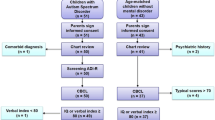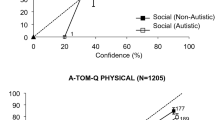Abstract
People with autism spectrum disorders (ASD) often take longer to make decisions. The Autism-Psychosis Model proposes that people with autism and psychosis show the opposite pattern of results on cognitive tasks. As those with psychosis show a jump-to-conclusions reasoning bias, those with ASD should show a circumspect reasoning bias. Jumping-to-conclusions was assessed in a sample of 20 adolescents with ASD and 23 age-matched controls using the jumping-to-conclusions beads task. Both groups demonstrated equivalent levels of confidence in decision-making, however the ASD group required more beads than controls before making their decision. Furthermore, there was a positive correlation between the beads required and degree of autism symptoms. Consistent with the Autism-Psychosis Model, a more circumspect reasoning bias was evident in ASD.


Similar content being viewed by others
Notes
Originally Systemizing was scored 1 for an agree response and 2 for a strongly agree response and zero otherwise. Hoekstra et al. used a 0, 1, 2, 3 rating response scale. In the present study for the ASD and control participants, these two scoring frameworks were highly correlated (r(43) = 0.96, p<0.001) and we retained the scoring of Hoeekstra et al..
References
Allman, J. M., Watson, K. K., Tetreault, N. A., & Hakeem, A. Y. (2005). Intuition and autism: A possible role for Von Economo neurons. TRENDS in Cognitive Sciences, 9, 367–373.
American Psychiatric Association. (2000). Diagnostic and statistical manual of mental disorders (4th ed., text rev.). Washington, DC: Author.
Baron-Cohen, S. (2002). The extreme male brain theory of autism. Trends in Cognitive Science, 6, 248–254.
Baron-Cohen, S. (2003). The essential difference: Men, women and the extreme male brain. Penguin: Basic Books.
Baron-Cohen, S. (2009). Autism: The empathizing–systemizing (E–S) theory. Annals of the New York Academy of Sciences, 1156, 68–80.
Baron-Cohen, S., Wheelwright, S., Skinner, R., Martin, J., & Clubley, E. (2001). The autism-spectrum quotient (AQ): Evidence from Asperger syndrome/high-functioning autism, males and females, scientists and mathematicians. Journal of Autism and Developmental Disorders, 31, 5–17.
Behrmann, M., Avidan, G., Leonard, G. L., Kimchi, R., Luna, B., Humphreys, K., et al. (2005). Configural processing in autism and its relationship to face processing. Neuropsychologia, 44, 110–129.
Brosnan, M., Ashwin, C., & Gamble, T. (2013). Greater empathizing and reduced systemizing in people who show a jumping-to-conclusions bias in the general population: Implications for psychosis. Psychosis: Psychological Social and Integrative Approaches, 5, 71–81.
Brosnan, M., Ashwin, C., Walker, I., & Donaghue, J. (2010). Can an ‘Extreme Female Brain’ be characterised in terms of psychosis? Personality and Individual Differences, 49, 738–742.
Brosnan, M. J., Scott, F. J., Fox, S., & Pye, J. (2004). Gestalt processing in autism: Failure to process perceptual relationships and the implications for contextual understanding. Journal of Child Psychology and Psychiatry, 45, 459–469.
Capps, L., Yirmiya, N., & Sigman, M. (1992). Understanding of simple and complex emotions in nonretarded-children with autism. Journal of Child Psychology and Psychiatry and Allied Disciplines, 33, 1169–1182.
Christ, S. E., Kanne, S. M., & Reiersen, A. M. (2010). Executive function in individuals with subthreshold autism traits. Neuropsychology, 24, 590–598.
Constantino, J. N., & Gruber, C. P. (2005). Social responsiveness scale (SRS). USA: Western Psychological Services.
Constantino, J. N., Lavesser, P. D., Zhang, Y., Abbacchi, A. M., Gray, T., & Todd, R. D. (2007). Rapid quantitative assessment of autistic social impairment by classroom teachers. Journal of the American Academy of Child and Adolescent Psychiatry, 46, 1668–1676.
Corcoran, R., Rowse, G., Moore, R., Blackwood, N., Kinderman, P., Howard, R., et al. (2008). A transdiagnostic investigation of ‘theory of mind’ and ‘jumping to conclusions’ in patients with persecutory delusions. Psychological Medicine, 38, 1577–1583.
Crespi, B., & Badcock, C. (2008). Psychosis and autism as diametrical disorders of the social brain. Behavioral and Brain Sciences, 31, 241–261.; discussion 261–320.
De Martino, B., Harrison, N. A., Knafo, S., Bird, G., & Dolan, R. J. (2008). Explaining enhanced logical consistency during decision-making in autism. Journal of Neuroscience, 28, 10746–10750.
Evans, J. S. T. B. T. (2008). Dual-processing accounts of reasoning, judgment, and social cognition. Annual Review of Psychology, 59, 255–278.
Farran, E. K., & Brosnan, M. J. (2011). Perceptual grouping abilities in individuals with autism spectrum disorder; exploring patterns of ability in relation to grouping type and levels of development. Autism Research, 4, 283–292.
Freeman, D. (2007). Suspicious minds: The psychology of persecutory delusions. Clinical Psychology Review, 27, 425–457.
Freeman, D., Pugh, K., & Garety, P. (2008). Jumping-to-conclusions and paranoid ideation in the general population. Schizophrenia Research, 120, 254–260.
Garety, P. A., Bebbington, P., Fowler, D., Freeman, D., & Kuipers, E. (2007). Implications for neurobiological research of cognitive models of psychosis. Psychological Medicine, 37, 1377–1391.
Garety, P. A., Freeman, D., Jolley, S., Dunn, G., Bebbington, P. E., Fowler, D., et al. (2005). Reasoning, emotions and delusional conviction in psychosis. Journal of Abnormal Child Psychology, 114, 373–384.
Golan, O., Ashwin, E., Granader, Y., McClintock, S., Day, K., Leggett, V., et al. (2010). Enhancing emotion recognition in children with autism spectrum conditions: An intervention using animated vehicles with real emotional faces. Journal of Autism and Developmental Disorders, 40, 269–279.
Golan, O., & Baron-Cohen, S. (2006). Systemizing empathy: Teaching adults with Asperger syndrome or high-functioning autism to recognize complex emotions using interactive multimedia. Development and Psychopathology, 18, 591–617.
Goldstein, G., Johnson, C. R., & Minshew, N. J. (2001). Attentional processes in Autism. Journal of Autism and Developmental Disorders, 31, 433–440.
Grandin, T. (2000). My mind is a web browser: How people with autism think. Cerebrum, 2, 14–22.
Grandin, T. (2002). Do animals and people with autism have true consciousness. Evolutionary Cognition, 8, 241–248.
Hoekstra, R. A., Vinkhuyzen, A. A. E., Wheelwright, S., Bartels, M., Boomsma, D. I., Baron-Cohen, S., et al. (2011). The construction and validation of an abridged version of the autism-spectrum quotient (AQ-Short). Journal of Autism and Developmental Disorders, 41, 589–596.
Johnson, S. A., Yechiam, E., Murphy, R. R., Queller, M. S., & Stout, J. C. (2006). Motivational processes and autonomic responsivity in Asperger’s disorder: Evidence from the Iowa gambling task. Journal of the International Neuropsychological Society, 12, 668–676.
Kanne, S. M., Christ, S. E., & Reiersen, A. M. (2009). Psychiatric symptoms and psychosocial difficulties in young adults with autistic traits. Journal of Autism and Developmental Disorders, 39, 827–833.
Langdon, R., Ward, P. B., & Coltheart, M. (2010). Reasoning anomalies associated with delusions in schizophrenia. Schizophrenia Bulletin, 36, 321–330.
Lincoln, T. M., Ziegler, M., Mehl, S., & Rief, W. (2010). The jumping-to-conclusions bias in delusions: Specificity and changeability. Journal of Abnormal Psychology, 119, 40–49.
Lord, C., Rutter, M., Goode, S., Heemsbergen, J., Jordan, H., Mawhood, L., et al. (1989). Autism diagnostic observation schedule: A standardized observation of communicative and social behavior. Journal of Autism and Developmental Disorders, 19, 185–212.
Luke, L., Clare, I. C. H., Ring, H., Redley, M., & Watson, P. (2012). Decision-making difficulties experienced by adults with autism spectrum conditions. Autism, 16, 612–621.
McKay, R., Langdon, R., & Coltheart, M. (2006). Need for closure, jumping-to-conclusions and decisiveness in delusion-prone individuals. Journal of Nervous Mental Disorders, 194, 422–426.
McKay, R., Langdon, R., & Coltheart, M. (2007). Jumping to delusions? Paranoia, probabilistic reasoning and need for closure. Cognitive Neuropsychiatry, 12, 362–376.
McPartland, J., Dawson, G., Webb, S., Panagiotides, H., & Carver, L. (2004). Event-related brain potentials reveal anomalies in temporal processing of faces in autism spectrum disorder. Journal of Child Psychology and Psychiatry, 45, 1235–1245.
Moritz, S., Van Quaquebeke, N., & Lincoln, T. (2012). Jumping to conclusions is associated with paranoia but not general Suspiciousness. Schizophrenia Research and Treatment, Article ID 384039, 9 pages.
Moritz, S., & Woodward, T. S. (2005). Jumping-to-conclusions in delusional and non-delusional schizophrenic patients. British Journal of Clinical Psychology, 44, 193–207.
Mottron, L., Dawson, M., Soulieres, I., Hubert, B., & Burack, J. A. (2006). Enhanced perceptual functioning in autism: An update and eight principles of autistic perception. Journal of Autism and Developmental Disorders, 36, 27–43.
Perry, T. D. (2008). A pilot study of social cognition training for adults with high-functioning autism. Ann Arbor, MI: UMI. https://cdr.lib.unc.edu/indexablecontent?id=uuid:ef5d1e16-6a40-4e44-9c6a-62f6febfcc0c&ds=DATA_FILE. Last accessed October 23, 2012.
Plaisted, K., Swettenham, J., & Rees, E. (1999). Children with autism show local precedence in a divided attention task and global precedence in a selective attention task. Journal of Child Psychology and Psychiatry, 40, 733–742.
Reiersen, A. M., Constantino, J. N., Grimmer, M., Martin, N. G., & Todd, R. D. (2008). Evidence for shared genetic influences on self-reported ADHD and autistic symptoms in young adult Australian twins. Twin Research and Human Genetics, 11(6), 579–585.
Rutherford, M. D., & McIntosh, D. N. (2007). Rules versus prototype matching: Strategies of perception of emotional facial expressions in the autism spectrum. Journal of Autism and Developmental Disorders, 37, 187–196.
Senju, A., Southgate, V., White, S., & Frith, U. (2009). Mindblind eyes: An absence of spontaneous theory of mind in Asperger Syndrome. Science, 325, 883–885.
Stone, V. E., Baron-Cohen, S., & Knight, R. T. (1998). Frontal lobe contributions to theory of mind. Journal of Cognitive Neuroscience, 10, 640–656.
Turner-Brown, L. M., Perry, T. D., Dichter, G. S., Bodfish, J. W., & Penn, D. L. (2008). Brief report: Feasibility of social cognition and interaction training for adults with high functioning autism. Journal of Autism and Developmental Disorders, 38, 1777–1784.
Wakabayashi, A., Baron-Cohen, S., Wheelwright, S., Goldenfeld, N., Delaney, J., Fine, D., et al. (2006). Development of short forms of the empathy quotient (EQ-Short) and the systemizing quotient (SQ-Short). Personality and Individual Differences, 41, 929–940.
Wechsler, D. (1999). Wechsler abbreviated scale of intelligence. Oxford: Pearson Assessment.
Wheelwright, S., Baron-Cohen, S., Goldenfeld, N., Delaney, J., Fine, D., Smith, R., et al. (2006). Predicting autism spectrum quotient (AQ) from the systemizing quotient-revised (SQ-R) and empathy quotient (EQ). Brain Research, 1079, 47–56.
Winter, M. (2003). Asperger syndrome: What teachers need to know. London: Jessica Kingsley Publishers.
Acknowledgments
Grant sponsor EPSRC; Grant number EP/G031975/1.
Author information
Authors and Affiliations
Corresponding author
Rights and permissions
About this article
Cite this article
Brosnan, M., Chapman, E. & Ashwin, C. Adolescents with Autism Spectrum Disorder Show a Circumspect Reasoning Bias Rather than ‘Jumping-to-Conclusions’. J Autism Dev Disord 44, 513–520 (2014). https://doi.org/10.1007/s10803-013-1897-5
Published:
Issue Date:
DOI: https://doi.org/10.1007/s10803-013-1897-5




